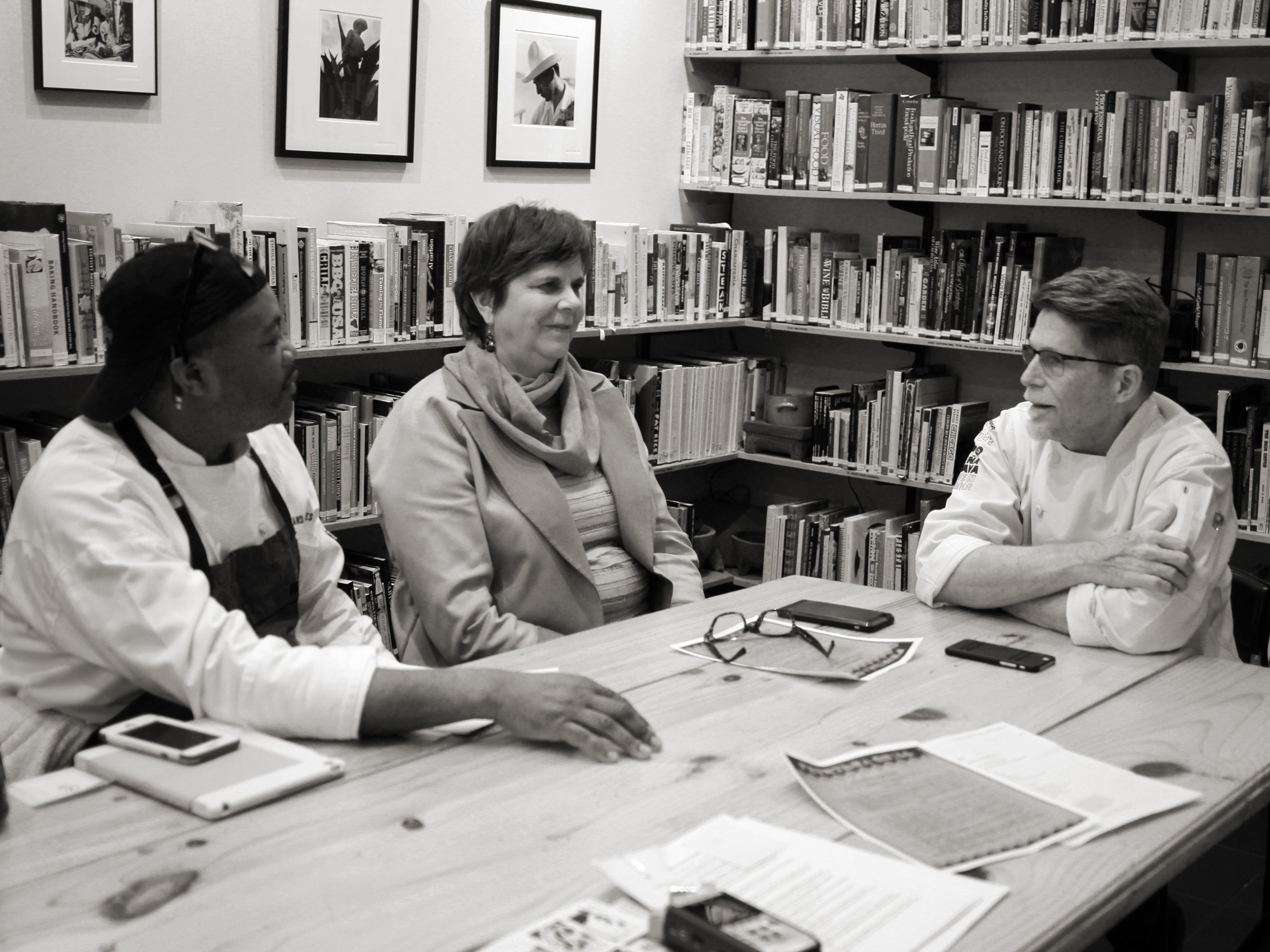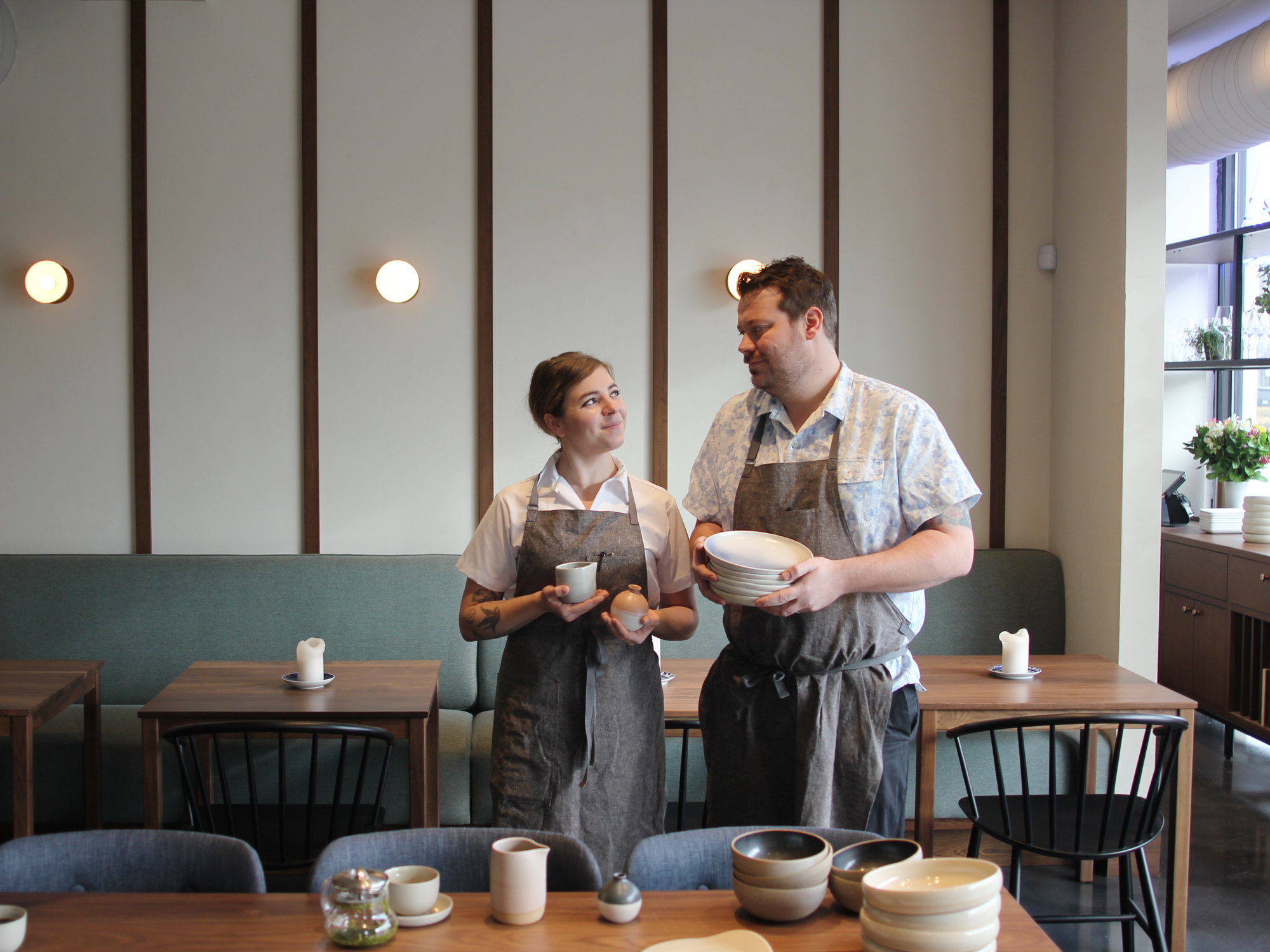MARGIE’S CANDIES WAS ALMOST EMPTY WHEN WE MET there at 2:30, but by the time we were finishing up, we knew when Margie’s weekday rush was—after school.
“See, this is what I love about ice cream,” Dana Cree said. “There’s all kinds of people, there’s kids just out of school, there’s a Mexican family, over there there’s an older couple having a little treat together. All united by ice cream.”
Cree is pastry chef at The Publican, and her resume boasts names from Alinea and Blackbird to the 1871 Dairy; at Blackbird she was twice a James Beard Foundation Finalist for Best Pastry Chef. But as the author of a new book called Hello, My Name is Ice Cream (which is also the name of her brand of artisan ice cream, available at Publican Quality Meats), it’s the simplest of desserts, not the complex ones she did at Alinea and Blackbird, that she identifies with. And wants to share with the world.
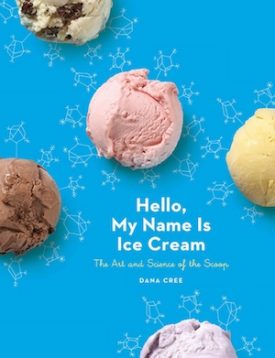
The book
I have a Cuisinart ice cream maker, the kind with the pre-frozen bowl, which she recommends (“I love that machine—it’s about as efficient as any kind of home machine is going to get”), plus a couple of dedicated ice cream books. So let me say with some home cook experience that her book is completely engaging and charming—thanks in no small part to the illustrations by Elske co-owner Anna Posey, who used to have Cree’s job at The Publican. And at the same time, it manages to get across some serious science of ice cream-making in a comprehensible way; it’s the kind of book your skills can grow with, which is the best kind of cookbook to me. (Besides the book, her website is designed to encourage readers to submit their own flavors or observations as they play with ice cream, too.)
Here’s what we talked about at Margie’s, as she had a Terrapin Sundae (“Two Scoops of Ice Cream Your Choice, Covered with Butter Scotch, Side Order of Fudge and Topped with a Turtle”) and I had a flavor she had never heard of, New York Cherry, which despite its name is a Chicago thing, found in all the old school ice cream joints.
FOODITOR: Tell me about your love affair with ice cream.
DANA CREE: My love affair started like most peoples’, so young I don’t even have a memory of my first taste of ice cream; it was just always there. I was very particular about my ice cream as a kid, it could not touch cake. So while everybody else at the family dinners had cake and ice cream, I insisted on a separate bowl.
I liked ice cream as much as the next person, and didn’t really think too much of it until I started culinary school and got into the baking and pastry program. Baking things was very cool, puff pastry was very cool, but you take a cookie from the oven, it doesn’t look that much different from the dough when you put it in. With ice cream, I don’t even know if I thought you could make it at home, because it seemed so magical. And when we made our first ice cream base with a custard, and then put it in a machine and it came out as ice cream, it just seemed like a magic trick to me.
When I first started working as a pastry chef, I started making ice cream professionally and did what everyone does, borrowed recipes from every pastry chef’s cookbook I could find. The second restaurant where I took over as a pastry chef had a Pacojet, which is a very different ice cream machine—it sort of flips the process on its head. With ice cream you put a liquid base into the machine, and it freezes and agitates it at the same time. For the Pacojet, you freeze it solid first and then put the canister in the machine and these blades spin and shave the ice while adding air.
So all of my recipes failed, miserably. I asked a friend of mine who I had met at The Fat Duck why my recipes didn’t work. He laughed, and told me I was about to open the biggest can of worms ever. I did; I took a peak under the hood of the science of ice cream, and it took me about ten years to dig to the bottom of that.
That started my professional love affair with how ice cream happens on a molecular level—how all these forces join together to create this texture that almost shouldn’t exist. It’s one of the only foods that we eat that’s a liquid, a solid and a gas at the same time. And getting all of those states of matter to stay put it is kind of challenging.
You spent a number of years doing very elaborate, very high end desserts at some of these restaurants—what brought you back to ice cream as your central focus?
I had sort of a moment at one of the fine dining restaurants I was working at, I ran some desserts out to a table and put them down in front of the guests, and they could have cared less what was on the plate, or whether I was there or not. There were some very, very lovely people in all of those dining rooms, but it just hit me that I was pouring my entire being into these desserts, that were only accessible to wealthy people. And that wasn’t me; I couldn’t afford to eat in those dining rooms. And the people in the dining rooms weren’t the people I grew up with.
So I just realized, ice cream is one of those things that I could share with everybody. And if I put everything I had into a scoop of ice cream, instead of a plated dessert that cost $18, I could create a memory for everybody. And that just really sort of meshed with who I am as a person.
[pours hot fudge on her Terrapin Sundae]
I love when hot fudge is actually hot. Because once it hits the ice cream, it’s cold.

Even high end ice cream is not that big an indulgence. Most of America can afford Häagen-Dazs once in a while.
True. It’s definitely an affordable luxury. And it’s not like I don’t still work at a restaurant that takes a certain means to eat at. But it made me want to pour more of myself into the craft of it.
But it’s easy for me to forget sometimes what actually happens in peoples’ homes, outside of these large cities that I work in, where there are three kids at home and a gallon of ice cream for $5 is the way to go.
Growing up like that we ate a lot of sherbet, which you talk about in the book but I feel like I don’t see as much any more. Or is gelato just the new name for sherbet?
I feel like sherbet is a lost art, almost. Legally speaking, it can contain no less than 2% butterfat, and no more than 4%. Gelato is a wild card in America, because legally there are no definitions for the word. So you could literally put anything you want in a pint and call it gelato.
Because sherbet is so low fat, I think it’s 100% the best way to show off fruit in ice cream. I wouldn’t say I’d never make a strawberry ice cream, but there’s so much water in the fruit that you can barely put any of the fruit in the ice cream without making it icy. So most strawberry ice creams you buy in the store are going to have a lot of strawberry flavor and very little fruit. When I went to Ice Cream College [at Penn State], whenever someone asked how to put fruit in an ice cream, they said add a ripple.
I realized ice cream is one of those things that I could share with everybody. And if I put everything I had into a scoop of ice cream, instead of a dessert that cost $18, I could create a memory for everybody.
A lot of the ice creams that you buy are completely bound by common manufacturing practices. And the common manufacturing practice for ice cream is to make a blank base in bulk, and then divide that up and add flavor on top of that. If you add strawberry puree to that, it’s going to throw the water content off. With homemade ice creams you have the opportunity to replace the water content from milk with the water content from fruit, which is what’s done with the sherbets.
Well, let’s talk about some tips for the home ice cream cook.
The two things you can do that will give you the biggest change in your home ice cream are, one, stabilizing the water, with one of the stabilizers, and curing your ice cream base overnight. Curing overnight is probably the least followed step at home, because when we cook at home we want instant gratification, which is fine, I totally get that. But what it does, that’s even more important at home, is that it recrystallizes the butterfat. And without hardening up that butterfat again, you won’t be able to trap air. It’s super, super important for the ultimate texture of ice cream.
Speaking of stabilizers, you observe in the book that we’ve all been scared off them, even as they’re part of molecular gastronomy, using some weird chemical like xanthan gum to put things together—
Just hearing you say “some weird chemical that puts things together”—I don’t think they’re weird at all. There’s a lot of things at home that we don’t know how to manufacture—there’s no way for us to get corn starch out of corn, but somehow that’s a completely natural product. Locust bean gum is a weird thing that holds stuff together, but carob chips, if you’re super-healthy and you don’t want to eat chocolate, but make chocolate chip cookies, well, they’re the same plant. So why does one have a perception that it’s healthy, and one has the perception that it’s a weird chemical?
For the most part, the gums that have been used in ice creams have been used for centuries and centuries. Locust bean gum, guar gum is a huge product of Texas at this point, it’s just the ground endosperm of a seed that happens to have a gummy texture. To make a blanket statement that stabilizers are bad does a disservice to the job that they do, and the fact that there are many many things that can do that job—eggs can be a stabilizer, eggs are an emulsifier. The protein in milk can help stabilize.
So I really tried to just shed some light on what they are and the job they do, and these are all of the things that can do that job—choose which one you want to put in your ice cream. If you want to. There’s a book out there that spends a great deal of time congratulating itself for figuring out how to make ice cream without stabilizers. You don’t have to figure that out—you just have to not put them in your ice cream.
The growth of ice crystals is the Achilles heel of ice cream, and the home cook is at such a disadvantage technically—our freezers will never hold the ice in place. Our machines will never turn the ice cream fast enough to not make those big ice crystals. So at home, it’s almost more important to use something to help stabilize the water, whether it’s corn starch or tapioca starch or egg yolks or simmer the milk powder a little bit longer. Something, just to help that ice stay put.
Let’s talk weird flavors. You mention that the first thing you did as a cook was push the flavor envelope, and that some of them were just too weird. Yet I notice that within a few pages of the base recipe you have toasted hay ice cream—if that’s not The Fat Duck all over—
Or Noma.
Cardamom ice cream, pumpkin sage—those are all pushing the average home’s limits, I think.
Yeah, sometimes I forget what is a normal flavor and what’s not. I’m so desensitized at this point.
But if you read the pumpkin sage recipe, you can see that you can pull the sage out and put the pumpkin spice in. If anything, what I wanted to do was inspire people, but also to empower them to make the flavors that they wanted to make. Hay ice cream is a little weird, but I felt like—and my agent felt like—as a professional pastry chef, I could get away with putting in one or two really out there flavors. And hay is out there—it’s not easy to find hay. I have to go harass the farmers at the farmers market for it.
You just toast it in the oven, and then you infuse it. It almost tastes like green tea—it’s really, really delicious.
Is there anything else where you felt like you were pushing Americans into new ice cream frontiers?
Yeah. I mean, I think this book really ran the risk of just grazing the tops of everyone’s heads—I put ratios in there, I put a lot of mathematics in there, I put a lot of science in there. I tried to do it in a way that could be approachable to everybody. But also, the parts that you don’t want to use can disappear into the background. So if you’re looking at a recipe, you don’t have to feel overwhelmed over what the ratios even mean, if all you’re doing is using the cups and spoons. You can just skip the science section and go to the doughnut ice cream recipe.
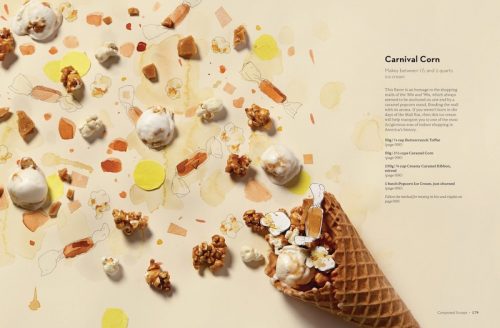 courtesy Dana Cree
courtesy Dana Cree I thought the science section was very good and very clear. Even after reading a few other books, I felt I understood better what goes on in ice cream.
Well, I tried to counterbalance the cerebral stuff with really pretty photos.
It’s a really good-looking book. Who did the photography?
Her name’s Andrea D’Agosto, she’s out in California. And then I got Anna Posey to do her drawings. When I was doing the proposal, I knew—first of all, if you look at ice cream, it’s literally the same thing 200 times. Maybe there’s a different color—I put the color section in last, after seeing just scoop after scoop after scoop from my recipe tester, and being like, it’s always the same, we have to do something about this!
You could have called it 50 Shades of Tan!
Yes. That could have been the title of this book. I wanted more visual reference for what ice cream was, because alone it doesn’t tell you. I’ve been scanning the pictures for Paul Kahan’s book and you put a picture of six salads side by side, it’s so clear what everything is, what’s in it. But with ice cream, I wanted to add more context to it. So we did these sort of photographic-illustration hybrids, played with planes of field and dimension. Not that looking at a scoop of ice cream on its own didn’t make you want to eat it.
But there’s not a single Photoshop picture in this book. These are all tiny little sets that we built. A lot of people just assume that it’s Photoshop—
So it’s ice cream sitting on some watercolor paint?
Yeah. 100% sets that we built. I did that thing where you find four talented people and put them in a room and, let them go.
Well, I thought it was interesting in that whole color section that you talk about adding color so it looks like what people’s perceptions of the flavors are. You put a little cocoa powder in something that has a spice in it, to get to the color that they think the spice imparts. And I love the intense blue spirulina coloring on the color page—
Blue Magik. That one’s so fun. I found this one because of that Real Good Juice company at Whole Foods, they do something called Bluice Wayne, they put this in there so I asked them how they got the color and they told me. It smells to high heaven, but I swear to God, you just need a pinch and it’s blue and you can’t taste anything in the ice cream.
Blue ice cream has such a fascination for kids. Mine would always get like Superman flavor or something.
In Italy, the kid’s flavor over there is called Puffo, which is Italian for Smurf, and it tastes like frosting, sugar and vanilla flavoring—that’s apparently what they’ve decided Smurfs taste like. The only thing we’ve done with it so far is, we did cotton candy ice cream, and we mixed pink and blue and swirled them together.
Did you hear that the big thing in New York right now is cookie dough? There’s like four hour lines for it at the famous place. Have these people never tasted cookie dough?
I like a bite of cookie dough.
I think if you’re eating a whole bowl of cookie dough, you’ve sacrificed your adult credentials.
The cookie dough cookie sandwich is the worst—cookie dough between two cookies. Although one of the things I did in this book is, I added a lot of cookie doughs to the ice creams. It’s a very contemporary add-on for ice creams—
Because you get a little chewy bit? That’s fine, I guess.
So we did an update to cookies and cream, it’s cookies, cookies and cream. Sounds like the law firm I’d want to go to. But we do the baked cookie dough and the raw cookie dough in there.
So what are some other Dana-approved add-ins? Do you do a peppermint ice cream?
Yeah, we do mint chocolate chip cookie dough—we infuse garden mint into a Philadelphia-style [eggless] base, color it with the spirulina, and then we add peppermint oil. The thing about commercial mint ice cream is, they just add peppermint extract so it’s very bracing. But mint is actually very sweet. So we infuse both fresh mint and a little peppermint oil in it, and then color it green for the mint chocolate chip.
And then we have the chocolate chunks that melt in your mouth—one of my pet peeves about ice cream is when they just chop up pieces of chocolate, because people work very hard to put chocolate in temper. And the property that they’re looking for is that it’s stable at room temperature. So if you have something that’s stable at room temperature, when you put it in your mouth, your mouth has to melt it in order to taste it. So if you freeze that, your mouth then has to bring that up to melting temperature. So we pull the chocolate out of temper by melting it, and then we add 10% neutral oil like canola oil, which actually has a very low melt point. Or coconut butter, which has a nice snap but melts very easily.
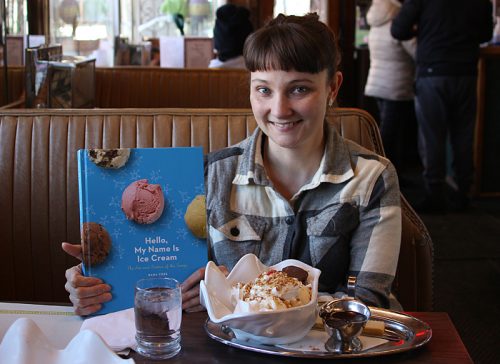
Graeter’s is a good example of someone who, if you leave the chocolate out at room temperature it’s fudgy, but you can bite into it. They still do a tinpot method, you can find videos of it and I find it really inspiring, they refused to move to modern manufacturing methods. So they spin it in 2-1/2 gallons at a time, the tinpot is like a tall pot that spins, and then you have to hand paddle and scrape it off the sides. So it basically just folds it on itself and it doesn’t add any air. They now have mechanical arms that do the folding, but you still have a guy with a wood paddle scraping all the ice cream out of his tinpot, throwing it in a bucket, scooting it on down to the person who packs it in the pints. Which is really cool.
Don’t they want to add air at that point?
No. That’s their texture. This tinpot style. I’ve definitely watched way too many videos of ice cream being manufactured.
So what are you serving at The Publican right now?
At Publican Anker, we have a variation on our Nutter Buddy ice cream. I call it Cosmo’s Delight, but A.J. [Walker], our chef, his pet peeve is when people put names on menus, so he just has it as chocolate, peanut butter, pretzel crunch, I think. But Cosmo [Goss, chef of The Publican] loves the Take 5 bar, which is caramel, peanut butter, pretzels, and eight more things going on. What else do we have…
I had the blood orange Dreamsicle—that was fantastic.
Thanks. We had that on all through the summer, we just switched it to a Meyer Lemon-Black Raspberry swirl. I think the swirl technique is one of the coolest things in the book. Whenever you want to mix two flavors, if you layer them in while they’re soft, they bleed into each other. So if you harden one, and then drop chunks of hard ice cream into a soft ice cream, the soft ice cream hardens around the hard ice cream and then you get really clean lines. So you can taste each flavor individually.
Let’s see… we have a cherry frozen yogurt with chocolate chunks and candied amarena cherries in it. I like to let my cooks and friends and sous chefs come up with flavors for the restaurant. Not because I’m too lazy to come up with flavors, but because that’s the thing about ice cream—you ask somebody about ice cream and they’ve got an opinion. Always. So if you say, hey what kind of ice cream should I make, you always get an answer. Nobody’s like, “I don’t know, I don’t really like ice cream.”
Michael Gebert is 31 flavors of editor of Fooditor.
Latest
Join the Discussion
After you comment, click Post. If you're not already logged in you will be asked to log in or register with Disqus.





